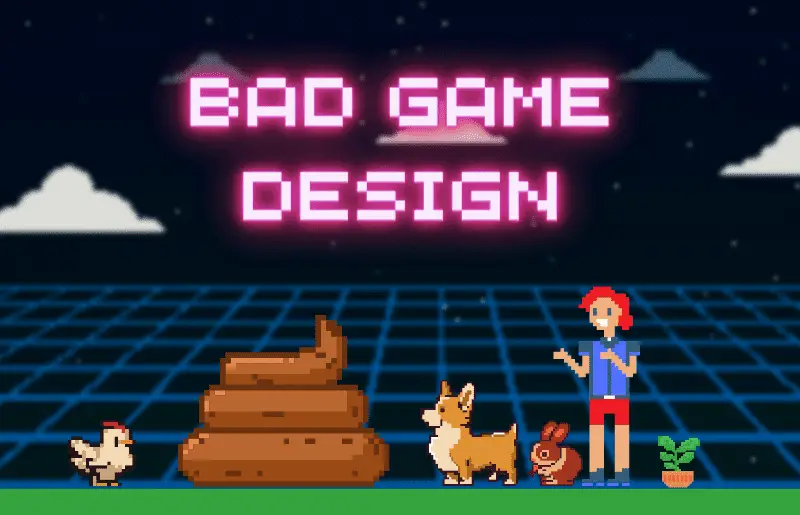What Is Bad Game Design?
If you’re thinking of making a video game, it’s important to learn from the games that have come before so that you can avoid bad game design.
So, what is bad game design? Video game design is focused on 5 main aspects: mechanics, space, goals, rules, and components. It’s important that every game development team gets all of these areas right. Failure to execute each of these aspects well will result in bad game design.
If a game isn’t designed and executed well, players may not even give it a chance. Those who do may return it within the money-back guarantee period, and those who don’t do that may get so annoyed with the problems in the game that they give up on it and never buy any downloadable content (DLCs) or updated versions of the game.
This could be a devastating for a game development company, so let’s take a closer look at each of the five key areas of game design and how to avoid having a badly designed game.
1. Bad Game Design Mechanics 
The mechanics of a game are the series of rules and feedback loops designed in such a way as to produce enjoyable gameplay. While these are necessary parts of gameplay, they can be done poorly, resulting in a disappointing experience for the players.
Since players tend to want to move on to the next thing and don’t enjoy redoing already completed content, unnecessary backtracking for the sake of lengthening a game is a sign of poor design. If the game developers want the game to be longer, they’d be better off writing new challenges or areas of the map to be explored, rather than forcing players back through content they’ve already seen and beaten.
Another bothersome game mechanic is unnecessary long explanations. Game players are smart, so they’re capable of figuring out what they’re supposed to do once they get going. They don’t need anything more than brief explanations here or there that can be X’ed out of quickly if they aren’t needed. Long explanations that players are forced to listen to or stare at for a long period of time whether they need it or not are unnecessary, a little insulting, and very annoying.
2. Bad Game Worldbuilding 
Each video game takes place in some kind of world. Whether it’s based in the real world or some other kind is up to the designers. The world is the environment in which the game takes place. In a spaceship, in the woods, during a historical period, in a current-time big US city, etc. Usually, the world will have some bearing on the method of movement through space as well, such as jumping, flying, running, floating, crawling, rolling, riding a horse, etc.
Sometimes different settings can be mismatched with various kinds of movement or other aspects of the way things work, but this can also be done poorly. Without a good reason for these factors to be mismatched, it may feel contrived and inauthentic to players.
Another way video game worldbuilding goes wrong is in the world’s history. Too often fantasy worlds have somehow existed forever but the ruling body has never changed hands. This makes a game in which the rulers are finally overthrown feel unlikely.
Players also roll their eyes when non-playable characters (NPCs) do things that don’t make sense for who they’ve shown themselves to be so far or what their own backstory would point to, but merely as a plot device to get the player to the next place. This kind of lazy planning is very disappointing and unpleasant to players and should always be avoided in game design.
3. Bad Goals In Video Games
Goals are absolutely necessary to every video game. The goal is what the player is working toward. It is how they will know that they’ve completed this section or won the game. Without goals, there’s little point to the game. Even non-strategic games have simple goals like catching as many fish as you can or making the most pieces fit together as possible.
Designers can miss the mark with video game goals when they continuously move the finish line for a goal, supply a disappointingly anticlimactic prize for reaching a goal, or worst of all, never clearly define the goal.
Players get frustrated quickly when they feel misled about the actual goal over and over again. And completing a goal only to find out that none of their choices actually had any effect on the result, or that the prize they thought they would get was less than they had been led to believe.
It’s important to clearly define the goal, when it will be achieved, and what the player will get to achieving it. Otherwise, it’s like breaking an agreement you made with your players. And repeated confusion and disappointment won’t make players anxious to return to your game.
4. Bad Game Design Rules
Rules are just as integral to video games as goals. Without set limitations, there would be no challenge to reaching the goal. Rules govern how players travel from one place to another, how long power boosting abilities last, how often players can find bonus tools that give them an advantage over others, where you spawn back to in relation to where you were killed, whether you can come back at all after being killed, etc.
While rules may be annoying in the moment when they make accomplishing a goal more challenging, it’s those goals and challenges that give the players the feeling of satisfaction for completing something difficult once they do reach goals within the game.
There’s also an important social aspect to rules. Many games have settings for parent-guided rules to prevent certain language from showing up in the chat in games for kids below a certain age. And players who bully other players or who cheat at the game may be booted from the system. These rules are set in place for the safety of all players and so that all players can enjoy the game. If rules weren’t in place, players wouldn’t be as protected from people with nefarious intentions.
5. Technical Bugs Can Ruin A Game 
Bugs in a game are perhaps one of the greatest aggravations for gamers. While bugs that enable your avatar to stand in the sky or skip a less-exciting step can be a fun surprise, most of them are incredibly inconvenient. These technical difficulties can cause crashes, stop events from triggering properly, stop controls from working correctly, and disable abilities that you worked hard or paid extra to acquire. Sometimes these bugs can even result in the game being shut down for a period of time while they are fixed.
Oftentimes these bothersome bits of messed-up code get missed as the game is being developed and then are caught by impatient players who are displeased with having to put up with them. Sometimes they can also be introduced later as some may be hiding in the latest updates being pushed out for a certain game.
While these bugs are always removable, players will appreciate never having to deal with them in the first place. And the computer engineers who may be put in charge of fixing them as quickly as possible after a game’s release would also rather them be caught earlier on.
All of these bad game design problems can be fixed before the game’s release to make their reception by players go over much more smoothly. Games with few to none of these problems are much more likely to be a success, as they will earn the trust of their players with satisfying gameplay from the beginning. If you’re working in game design now, be sure to avoid these aggravating problems so that your players will enjoy your product and keep coming back for more.
Thanks for reading! You can learn more about avoiding bad game design in the article I wrote here.

